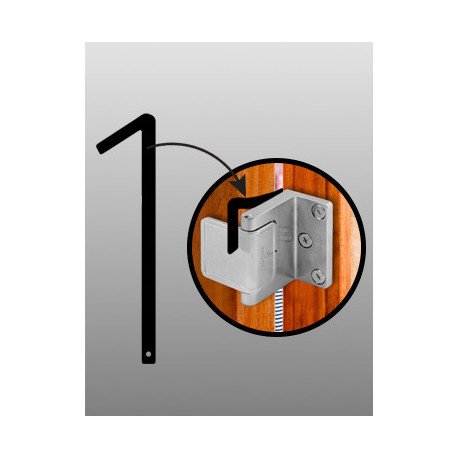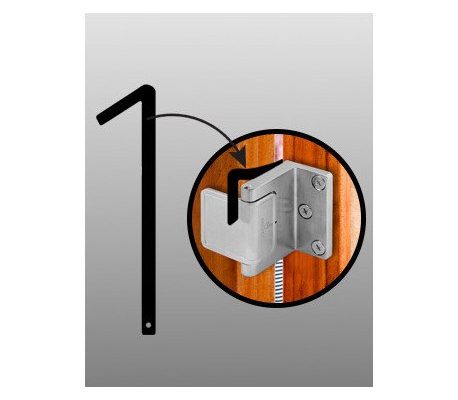
If you’ve got a privacy latch on your hands that’s causing some frustration, you’re not alone. It’s a common issue, and thankfully, most problems are easy to fix with just a little patience and know-how. Whether you’re dealing with a simple push-button latch or a lever-style model from a popular brand like Schlage or Kwikset, understanding how these mechanisms work can save you time and hassle. Let’s dive into the nuts and bolts of troubleshooting your privacy latch so you can get that door operating smoothly again.
Understanding How a Privacy Latch Works
Before diving into solutions, it’s good to know how a privacy latch operates. At its core, a privacy latch is a simple locking mechanism that typically operates with a button or lever. When engaged, it prevents anyone from opening the door from the outside, offering you privacy.
Here’s how it usually works: When you push the button from the inside, a small locking pin engages, preventing the door from being opened without a key or tool from the outside. Conversely, when you press the button or turn the lever again, the pin retracts, allowing the door to open freely. It’s pretty straightforward, but like any mechanical device, it can face issues over time.
You might be wondering, “What causes these problems?” Sometimes it’s as simple as dirt or grime, while other times it may be due to wear and tear on the locking mechanism itself. Let’s explore some common troubleshooting steps to get your latch back on track.
Check for Obstructions
The first step in troubleshooting a privacy latch that won’t engage or disengage is to visually inspect it for any obstructions. Over time, dust, hair, or other debris can accumulate on and around the latch mechanism, preventing it from functioning properly.
Take a close look at the area around the latch. If you spot any dirt or objects, clean them away. You can use a soft brush or even a cotton swab to get into tricky spots. If you’re struggling to clean it thoroughly, a bit of compressed air can help blow out trapped dust.
Don’t forget to check inside the mechanism itself, too. If you have access, you may be able to remove the plate covering the latch to clear out any obstructions. Just be careful not to lose any small parts in the process!
Inspect the Latch Mechanism
If no obstructions are visible, it’s time to inspect the latch mechanism itself. Sometimes, the components can become loose or misaligned. A simple visual inspection can go a long way. Look for any signs of wear or damage.
You might want to try gently pressing or pulling the latch lever to see if anything feels off. If it wiggles excessively or doesn’t return to its original position, it may need some adjustment. Tightening any screws or bolts can help improve alignment.
If you’re comfortable with a screwdriver, you can remove the latch from the door. This will give you a better view of the inner workings. Check for rust or corrosion, as well. If you find any, a bit of lubricant might be just what the doctor ordered.
Lubrication Is Key
Speaking of lubrication, this is often the secret sauce to fixing a privacy latch that won’t engage or disengage. Just like a bicycle chain that squeaks after a long ride, your latch might simply need a little oil to get back to smooth operation.
Here’s a quick guide to lubricating your latch:
- Choose the Right Lubricant: Use a silicone spray or graphite powder, as they won’t attract dust like oil-based lubricants.
- Apply Sparingly: A little goes a long way. Lightly spray or sprinkle the lubricant onto the moving parts of the latch.
- Work It In: Open and close the latch several times to work the lubricant into the mechanism.
Lubricating your latch can significantly reduce friction, allowing it to engage and disengage smoothly again. If it’s still sticky after lubrication, further investigation might be required.
Consider the Alignment of the Strike Plate
Sometimes, the problem isn’t with the latch itself but rather with the strike plate—the part on the doorframe that the latch interacts with. If the two aren’t aligned properly, even the best latch will struggle to engage or disengage.
Start by examining the alignment. When the door is closed, the latch should smoothly fit into the hole of the strike plate without any obstruction. If it’s not aligned, you can try loosening the screws on the strike plate and adjusting its position slightly.
If the latch is consistently misaligned, it might be worth checking if the door itself has shifted over time. Sometimes, tightening the door hinges or adjusting the strike plate can solve the problem.
Testing for Mechanical Failure
If you’ve gone through all the previous steps and your privacy latch still won’t engage or disengage, it could be experiencing mechanical failure. This is where things can get a bit tricky.
To test for mechanical failure, you might need to disassemble the latch completely. Look for any broken springs or disconnected components. If you notice anything out of place, replacement parts may be required.
Before you purchase new pieces, consider whether your latch is worth repairing. If it’s old or worn out, a new latch might be a better investment. Always keep your receipts, as most hardware stores offer return policies if you find out you don’t need that part after all!
Installing a New Privacy Latch
If all else fails, it might be time to install a new privacy latch. This can sound daunting, but it’s a straightforward process that many can handle themselves.
To get started, you’ll need:
- A new privacy latch (select one that fits your door).
- A screwdriver (usually a Phillips head).
- A measuring tape (to ensure proper fit).
Here’s a quick rundown of what to do:
1. Remove the Old Latch: Unscrew it from the door. Keep the screws in a safe place.
2. Install the New Latch: Align it with the holes from the old latch, ensuring proper orientation.
3. Secure Everything: Tighten the screws but don’t over-tighten, as this can damage the latch.
4. Test the Mechanism: Make sure it engages and disengages smoothly before closing the door fully.
Installing a new latch doesn’t just solve your current issue; it also enhances your home’s security and functionality.
Wrap-Up: Enjoying Peace of Mind
Troubleshooting a privacy latch that won’t engage or disengage can be frustrating, but with a little patience and some simple tools, you can usually resolve the problem yourself. Whether it’s cleaning, lubricating, aligning, or replacing your latch, each step gets you closer to a secure and functional door.
Remember, understanding how these mechanisms work is half the battle. And if all else fails, seeking help from a professional can provide peace of mind. No one wants to feel trapped in their own home, so tackling these issues head-on pays off in the long run. Happy fixing!
